From Shadows to Signatures: Interpreting Bypass Diode Faults in PV Modules Under Partial Shading Through Data-Driven Models
Abstract
1. Introduction
2. Background and Problem Definition
2.1. PV Array Configuration and Simulink Setup
2.2. Bypass Diode Current Behavior Under Shading
- Scenario A: Uniform irradiance of 1000 W/m2 applied to all 30 submodules.
- Scenario B: Non-uniform irradiance with the first module receiving 400 W/m2, the next one-third of the string receiving 700 W/m2, and the remaining two-thirds receiving 600 W/m2.
- Scenario C: Non-uniform low irradiance where the first module receives 100 W/m2, followed by half of the string at 200 W/m2 and the rest at 300 W/m2.
3. I-V Curve-Based Data Generation Under Partial Shading
3.1. I-V Curve Analysis Across Fault Conditions
3.2. Data Generation and Preprocessing
4. Proposed ANN-Based Classification Model
- High adaptability to different operating conditions without the need for rule-based reconfiguration.
- Superior generalization when trained with sufficiently diverse datasets, enabling robust performance under unseen scenarios.
- Tolerance to noisy or partially redundant features, which is particularly beneficial when working with real-world PV data.
4.1. Network Structure and Training Performance
4.2. Comparative Evaluation with Other Methods
5. Discussion and Results
Funding
Institutional Review Board Statement
Informed Consent Statement
Data Availability Statement
Conflicts of Interest
Abbreviations
| PV | Photovoltaic |
| BP | Bypass |
| I-V | Current–voltage |
| MPP | Maximum power point |
| ANN | Artificial neural network |
| SVM | Support vector machine |
| RF | Random forest |
| CNN | Convolutional neural network |
| AUC | Area under curve |
| ROC | Receiver operating characteristic |
References
- Niazi, K.A.K.; Kerekes, T.; Dolara, A.; Yang, Y.; Leva, S. Performance assessment of mismatch mitigation methodologies using field data in solar photovoltaic systems. Electronics 2022, 11, 1938. [Google Scholar] [CrossRef]
- Niazi, K.A.K.; Yang, Y.; Kerekes, T.; Sera, D. Reconfigurable distributed power electronics technique for solar PV systems. Electronics 2021, 10, 1121. [Google Scholar] [CrossRef]
- Wang, M.-H.; Lin, Z.-H.; Lu, S.-D. A fault detection method based on CNN and symmetrized dot pattern for PV modules. Energies 2022, 15, 6449. [Google Scholar] [CrossRef]
- Wang, M.-H.; Hung, C.-C.; Lu, S.-D.; Lin, Z.-H.; Kuo, C.-C. Fault diagnosis for PV modules based on AlexNet and symmetrized dot pattern. Energies 2023, 16, 7563. [Google Scholar] [CrossRef]
- Ayunts, H.; Agaian, S.; Grigoryan, A. SlantNet: A lightweight neural network for thermal fault classification in solar PV systems. Electronics 2025, 14, 1388. [Google Scholar] [CrossRef]
- Boubaker, S.; Kamel, S.; Ghazouani, N.; Mellit, A. Assessment of machine and deep learning approaches for fault diagnosis in photovoltaic systems using infrared thermography. Remote. Sens. 2023, 15, 1686. [Google Scholar] [CrossRef]
- Ramirez, I.S.; Das, B.; Marquez, F.P.G. Fault detection and diagnosis in photovoltaic panels by radiometric sensors embedded in unmanned aerial vehicles. Prog. Photovolt. Res. Appl. 2022, 30, 240–256. [Google Scholar] [CrossRef]
- Mellit, A.; Herrak, O.; Casas, C.R.; Pavan, A.M. A machine learning and internet of things-based online fault diagnosis method for photovoltaic arrays. Sustainability 2021, 13, 13203. [Google Scholar] [CrossRef]
- Raeisi, H.A.; Sadeghzadeh, S.M. A novel experimental and approach of diagnosis, partial shading, and fault detection for domestic purposes photovoltaic system using data exchange of adjacent panels. Int. J. Photoenergy 2021, 2021, 9956433. [Google Scholar] [CrossRef]
- He, W.; Yin, D.; Zhang, K.; Zhang, X.; Zheng, J. Fault detection and diagnosis method of distributed photovoltaic array based on fine-tuning naive Bayesian model. Energies 2021, 14, 4140. [Google Scholar] [CrossRef]
- Ko, J.; Kim, C.; Lee, D.; Lee, S.; Shin, W.G.; Kang, G.H.; Oh, J.; Ko, S.W.; Song, H.-J. Real-time detection and classification of bypass diode-related faults in photovoltaic modules via thermoelectric devices. Adv. Mater. Technol. 2024, 9, 2301209. [Google Scholar] [CrossRef]
- Dhakshinamoorthy, M.; Sundaram, K.; Murugesan, P.; David, P.W. Bypass diode and photovoltaic module failure analysis of 1.5 kW solar PV array. Energy Sources Part A 2022, 44, 4000–4015. [Google Scholar] [CrossRef]
- Hamada, T.; Nakamoto, K.; Nanno, I.; Fujii, M.; Oke, S.; Ishikura, N. Characteristics of failure Schottky barrier diode and PN junction diode for bypass diode using induced lightning serge test. In Proceedings of the 7th International Conference on Renewable Energy Research and Applications (ICRERA), Paris, France, 14–17 October 2018. [Google Scholar]
- Hamada, T.; Nakamoto, K.; Nanno, I.; Ishikura, N.; Oke, S.; Fujii, M. Fault characteristics of Schottky barrier diode used as bypass diode in photovoltaic module against repetitive surges. In Proceedings of the 47th IEEE Photovoltaic Specialists Conference (PVSC), Calgary, AB, Canada, 15–21 August 2020. [Google Scholar]
- Shin, W.G.; Ko, S.W.; Song, H.J.; Ju, Y.C.; Hwang, H.M.; Kang, G.H. Origin of bypass diode fault in c-Si photovoltaic modules: Leakage current under high surrounding temperature. Energies 2018, 11, 2416. [Google Scholar] [CrossRef]
- Hamada, T.; Azuma, T.; Nanno, I.; Ishikura, N.; Fujii, M.; Oke, S. Impact of bypass diode fault resistance values on burnout in bypass diode failures in simulated photovoltaic modules with various output parameters. Energies 2023, 16, 5879. [Google Scholar] [CrossRef]
- Ul-Haq, A.; Fahad, S.; Gul, S.; Bo, R. Intelligent control schemes for maximum power extraction from photovoltaic arrays under faults. Energies 2023, 16, 974. [Google Scholar] [CrossRef]
- Dhimish, M.; Chen, Z. Novel open-circuit photovoltaic bypass diode fault detection algorithm. IEEE J. Photovolt. 2019, 9, 1819–1827. [Google Scholar] [CrossRef]
- Toche Tchio, G.M.; Kenfack, J.; Voufo, J.; Mindzie, Y.A.; Njoya, B.F.; Ouro-Djobo, S.S. Diagnosing faults in a photovoltaic system using the Extra Trees ensemble algorithm. AIMS Energy 2024, 12, 727–750. [Google Scholar] [CrossRef]
- Lu, S.-D.; Wang, M.-H.; Wei, S.-E.; Liu, H.-D.; Wu, C.-C. Photovoltaic module fault detection based on a convolutional neural network. Processes 2021, 9, 1635. [Google Scholar] [CrossRef]
- Aljafari, B.; Satpathy, P.R.; Thanikanti, S.B.; Nwulu, N. Supervised classification and fault detection in grid-connected PV systems using 1D-CNN: Simulation and real-time validation. Energy Rep. 2024, 12, 2156–2178. [Google Scholar] [CrossRef]
- Fauzan, L.; Sim, Y.H.; Yun, M.J.; Choi, H.; Lee, D.Y.; Cha, S.I. Power from shaded photovoltaic modules through bypass-diode-assisted small-area high-voltage structures. Renew. Sustain. Energy Rev. 2025, 208, 115047. [Google Scholar] [CrossRef]
- Baranwal, K.; Prakash, P.; Yadav, V.K. Optimizing bypass diode performance with modified hotspot mitigation circuit. Sol. Energy Mater. Sol. Cells 2025, 280, 113281. [Google Scholar] [CrossRef]
- Lu, S.-D.; Wu, C.-C.; Sian, H.-W. A novel fault diagnosis method for PV arrays using convolutional extension neural network with symmetrized dot pattern analysis. IET Sci. Meas. Technol. 2024, 18, 49–64. [Google Scholar] [CrossRef]
- Lee, C.G.; Shin, W.G.; Lim, J.R.; Kang, G.H.; Ju, Y.C.; Hwang, H.M.; Chang, H.S.; Ko, S.W. Analysis of electrical and thermal characteristics of PV array under mismatching conditions caused by partial shading and short circuit failure of bypass diodes. Energy 2021, 218, 119480. [Google Scholar] [CrossRef]
- Sezgin-Ugranlı, H.G. Photovoltaic system performance under partial shading conditions: Insight into the roles of bypass diode numbers and inverter efficiency curve. Sustainability 2025, 17, 4626. [Google Scholar] [CrossRef]
- Sezgin-Ugranlı, H.G. To what extent the number of bypass diodes influence the performance of PV modules: Probabilistic assessment. Renew. Energy 2025, 249, 123243. [Google Scholar] [CrossRef]
- MathWorks. Solar Cell. Available online: https://www.mathworks.com/help/sps/ref/solarcell.html (accessed on 18 July 2025).[Green Version]
- Bartholomäus, M.; Morino, L.; Poulsen, P.B.; Spataru, S.V. Evaluating the accuracy of inverter-based string IV measurements. In Proceedings of the 40th European Photovoltaic Solar Energy Conference and Exhibition (EU PVSEC), Lisbon, Portugal, 18–22 April 2023. [Google Scholar][Green Version]
- Huawei. Smart I-V Curve Diagnosis on the NetEco. Available online: https://support.huawei.com/enterprise/en/doc/EDOC1100047682/f3a36f36/smart-i-v-curve-diagnosis-on-the-neteco (accessed on 18 July 2025).[Green Version]
- Nunes da Silva, I.; Spatti, D.H.; Flauzino, R.A.; Liboni, L.H.B.; dos Reis Alves, S.F. Artificial Neural Networks: A Practical Course; Springer International Publishing: Cham, Switzerland, 2017. [Google Scholar][Green Version]
- Yuan, Z.; Xiong, G.; Fu, X. Artificial neural network for fault diagnosis of solar photovoltaic systems: A Survey. Energies 2022, 15, 8693. [Google Scholar] [CrossRef]
- Chine, W.; Mellit, A.; Lughi, V.; Malek, A.; Sulligoi, G.; Massi Pavan, A. A novel fault diagnosis technique for photovoltaic systems based on artificial neural networks. Renew. Energy 2016, 90, 501–512. [Google Scholar] [CrossRef]
- Voutsinas, S.; Karolidis, D.; Voyiatzis, I.; Samarakou, M. Development of a multi-output feed-forward neural network for fault detection in photovoltaic systems. Energy Rep. 2022, 8, 33–42. [Google Scholar] [CrossRef]
- Syafaruddin; Karatepe, E.; Hiyama, T. Controlling of artificial neural network for fault diagnosis of photovoltaic array. In Proceedings of the 16th International Conference on Intelligent System Applications to Power Systems, Hersonissos, Greece, 25–28 September 2011; pp. 1–6. [Google Scholar]
- Elobaid, L.M.; Abdelsalam, A.K.; Zakzouk, E.E. Artificial neural network-based photovoltaic maximum power point tracking techniques: A survey. IET Renew. Power Gener. 2015, 9, 1043–1063. [Google Scholar] [CrossRef]
- Schölkopf, B.; Smola, A.J. Learning with Kernels: Support Vector Machines, Regularization, Optimization, and Beyond; MIT Press: Cambridge, MA, USA, 2002. [Google Scholar]
- Goodfellow, I.; Bengio, Y.; Courville, A. Deep Learning; MIT Press: Cambridge, MA, USA, 2016. [Google Scholar]
- Mehmood, A.; Sher, H.A.; Murtaza, A.F.; Al-Haddad, K. A diode-based fault detection, classification, and localization method for photovoltaic array. IEEE Trans. Instrum. Meas. 2021, 70, 3516812. [Google Scholar] [CrossRef]
- Oke, S.; Sakai, H.; Tottori, H.; Shimizu, Y.; Nanno, I.; Hamada, T.; Ishikura, N.; Fujii, M. Characteristics and risks of broken bypass diode with induced lightning. In Proceedings of the Grand Renewable Energy, Yokohama, Japan, 17–22 June 2018. [Google Scholar]
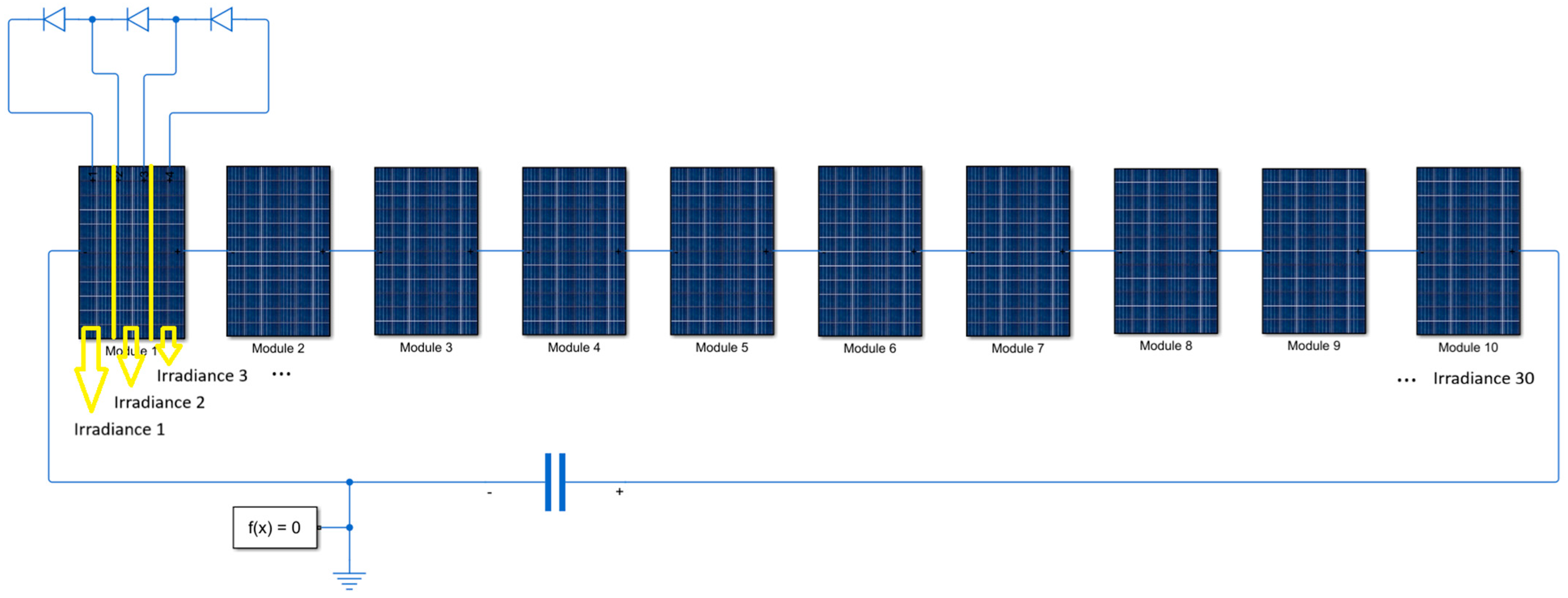
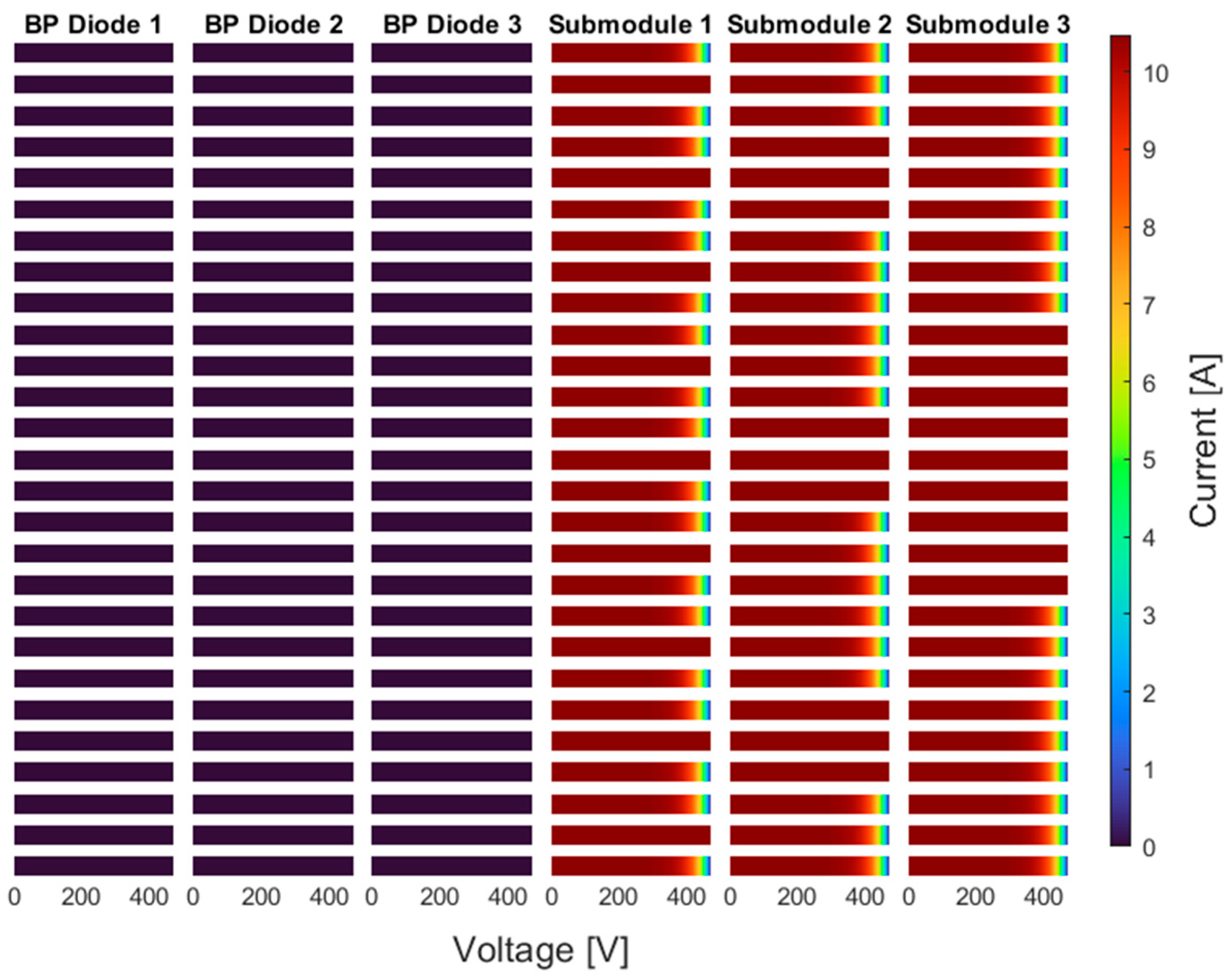
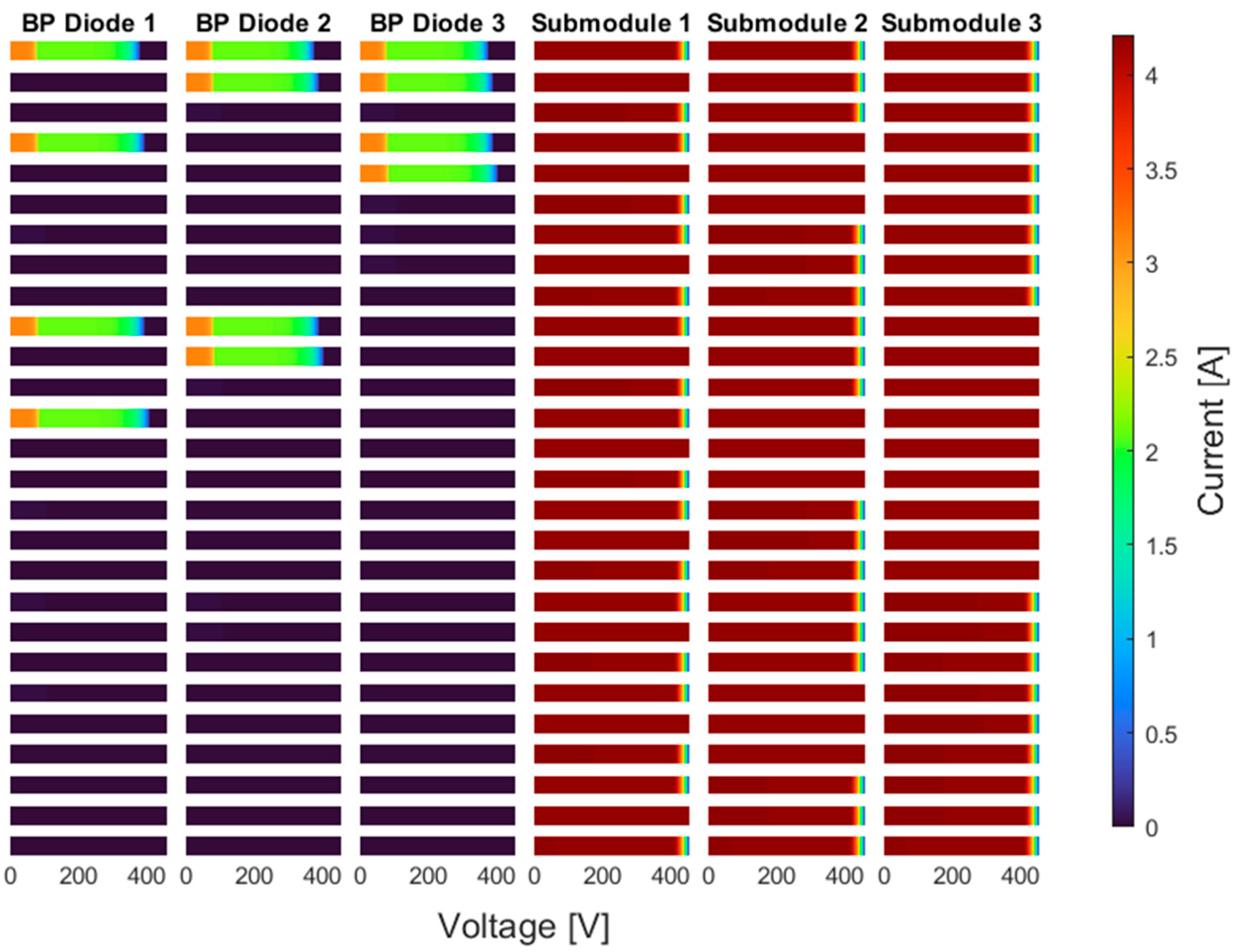
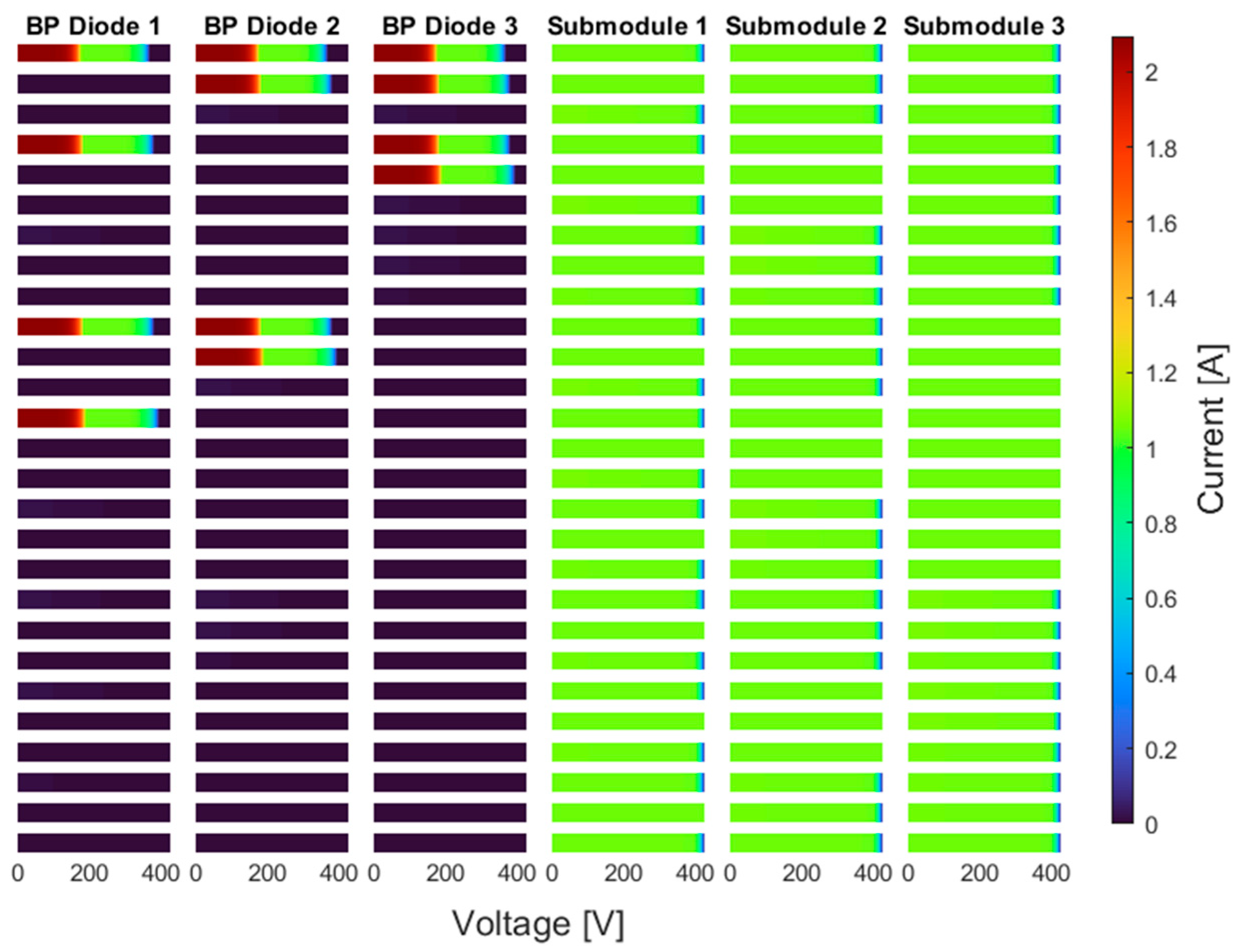

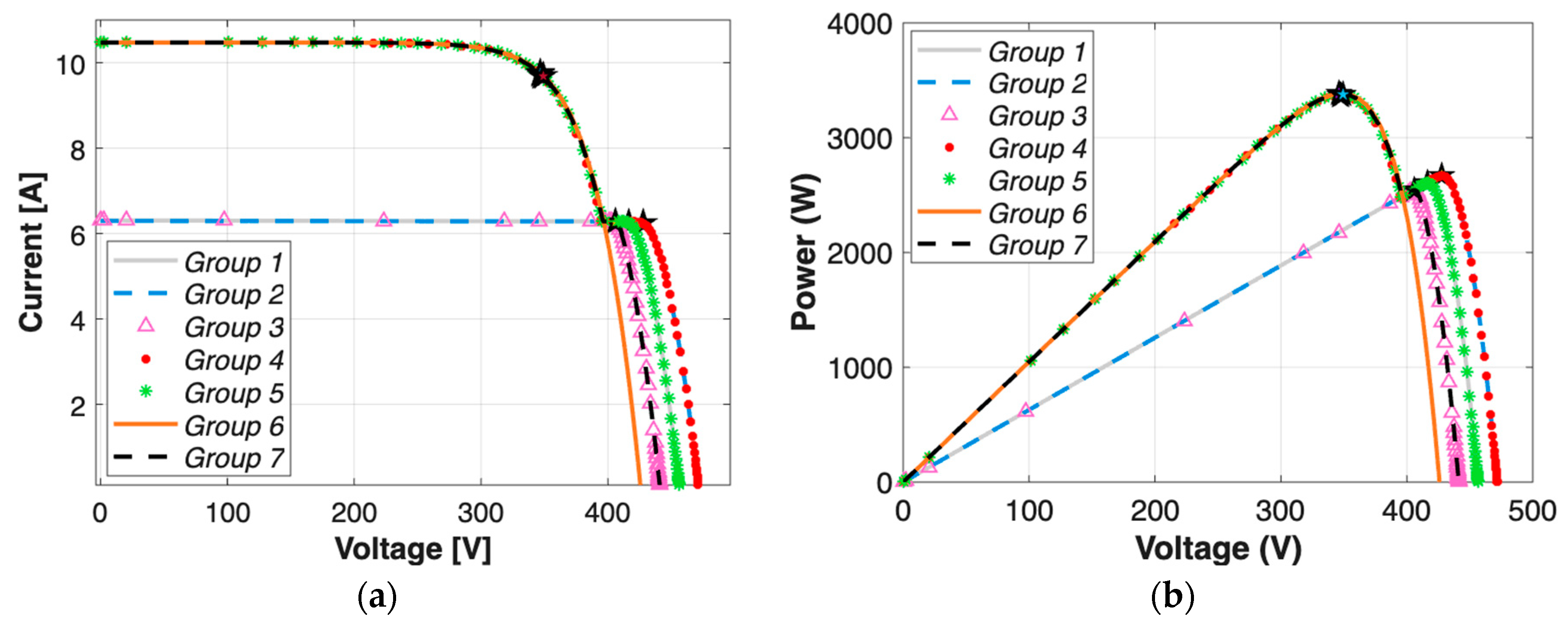

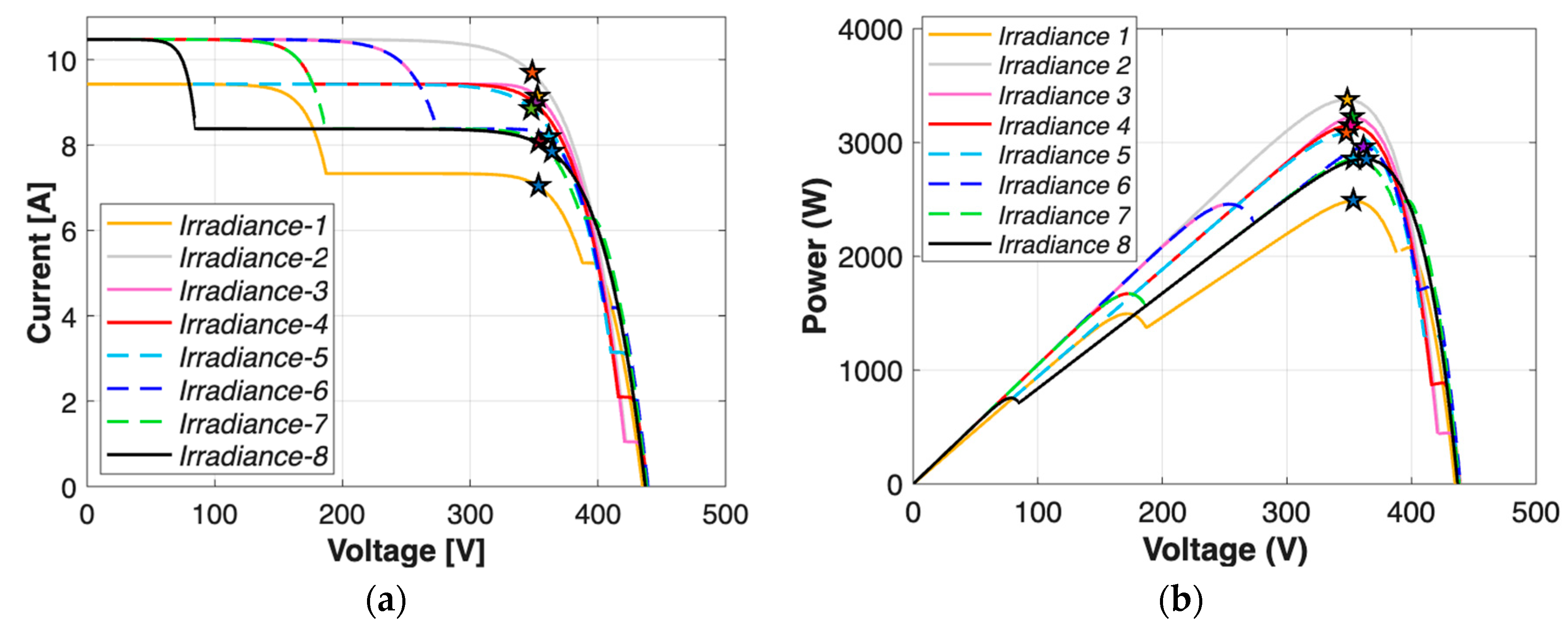
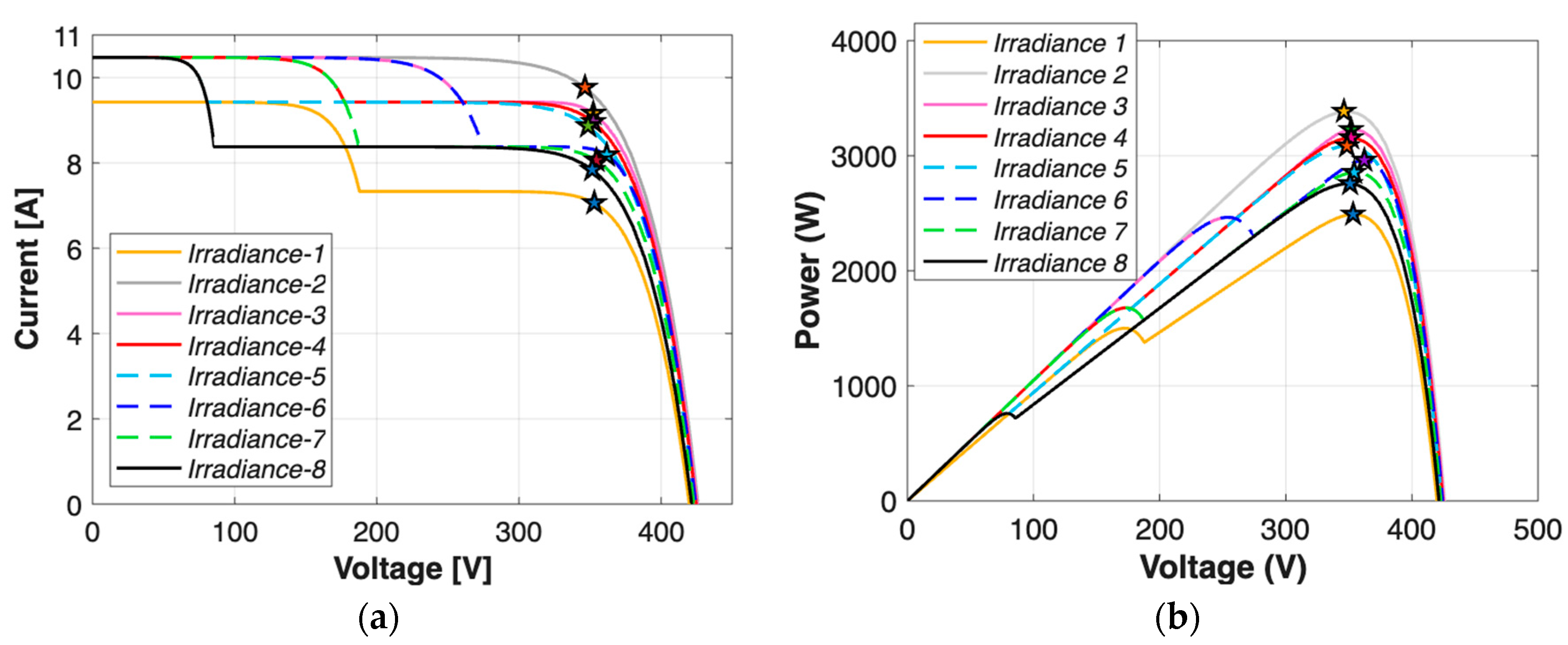

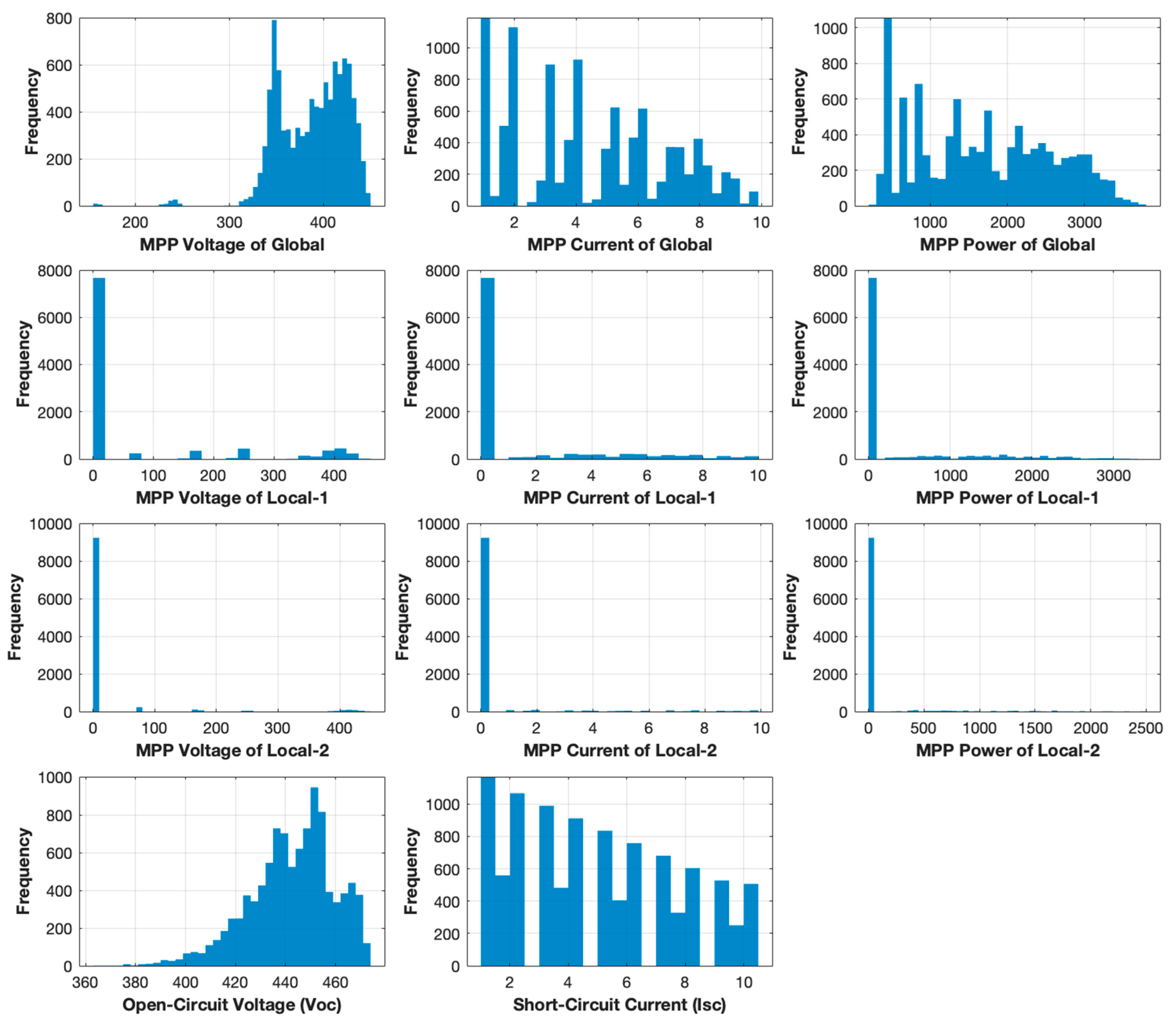
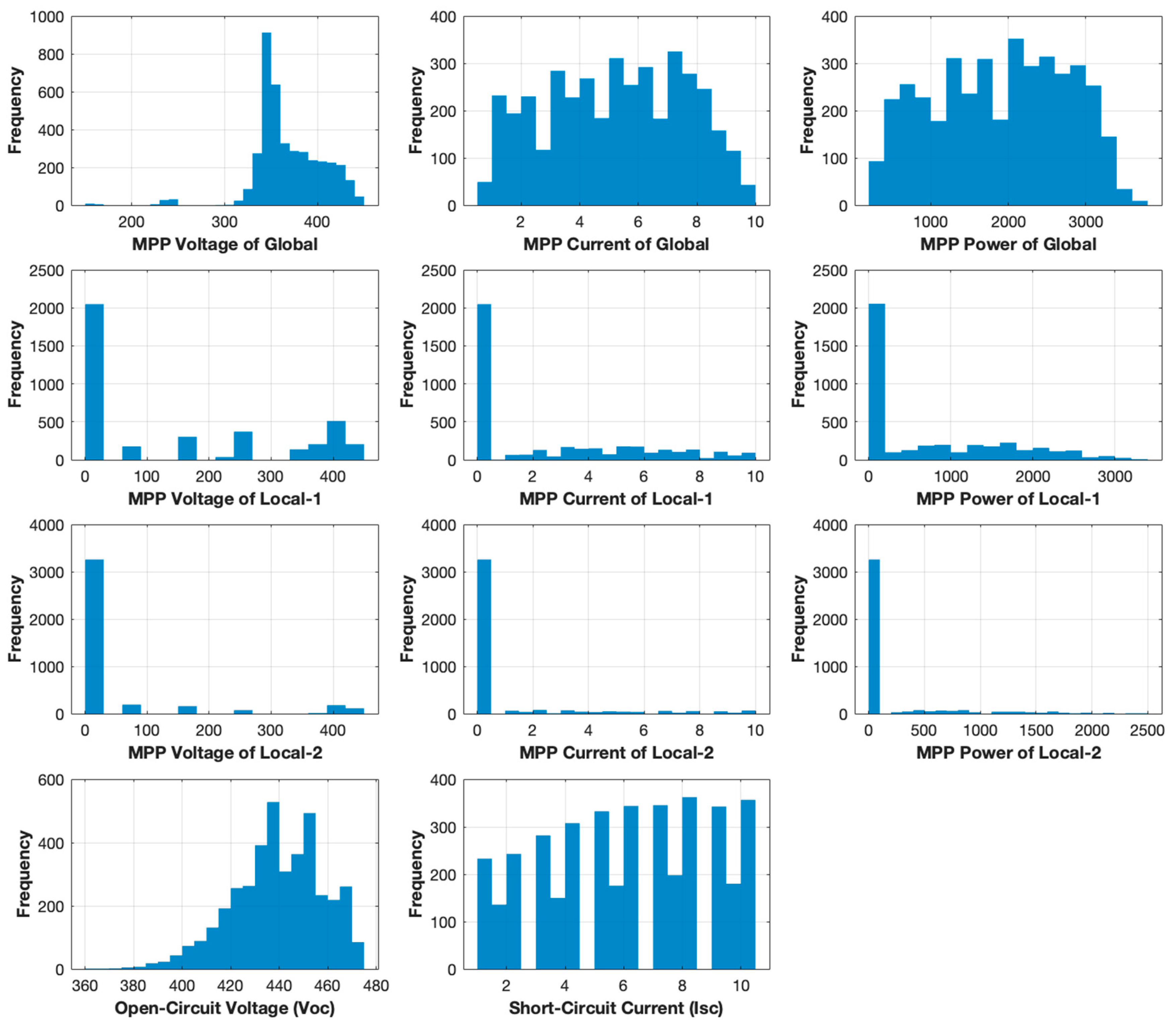


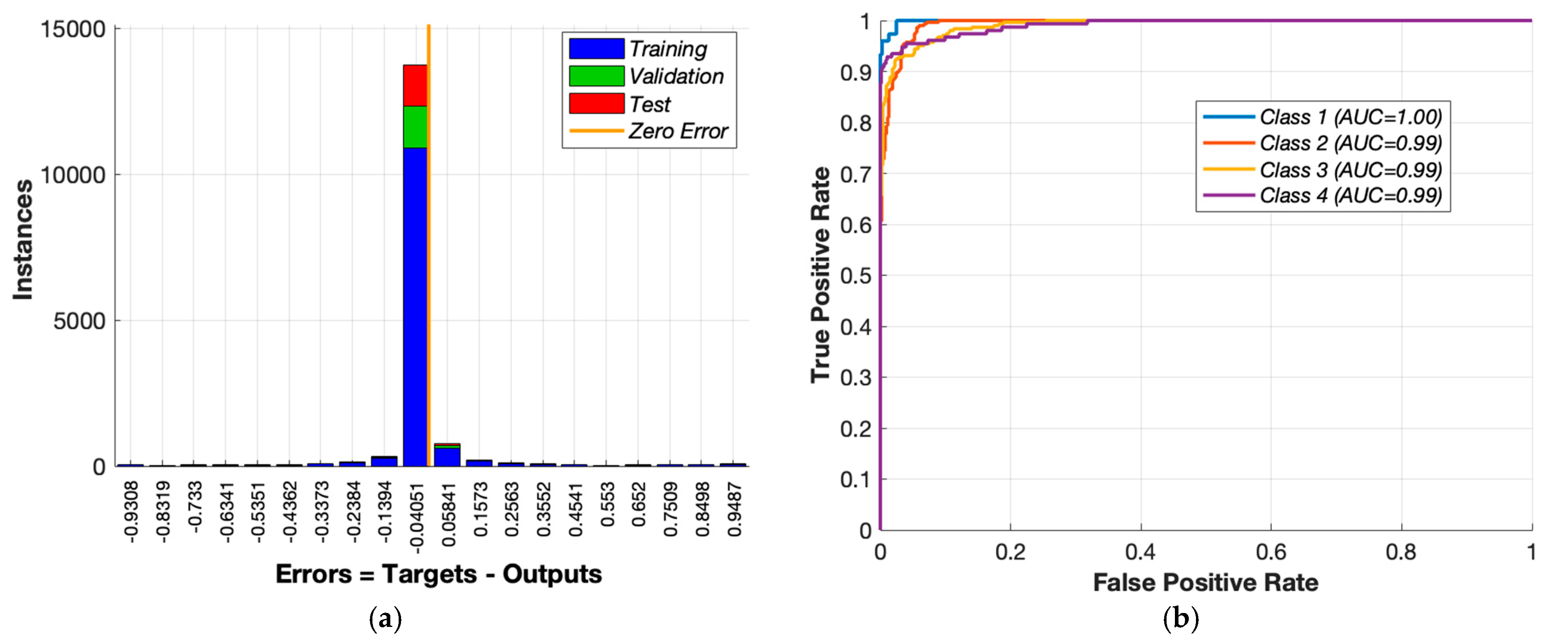
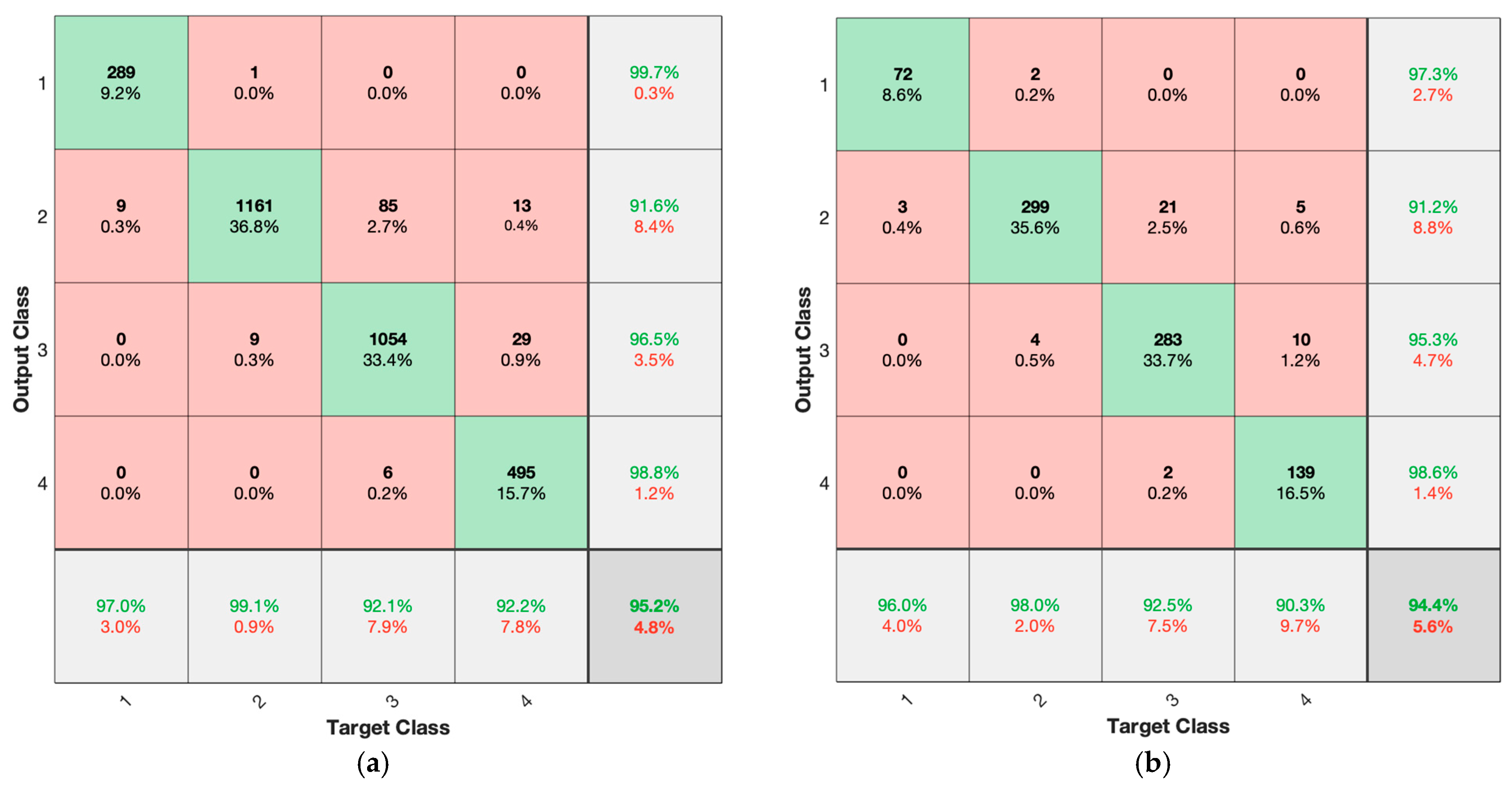
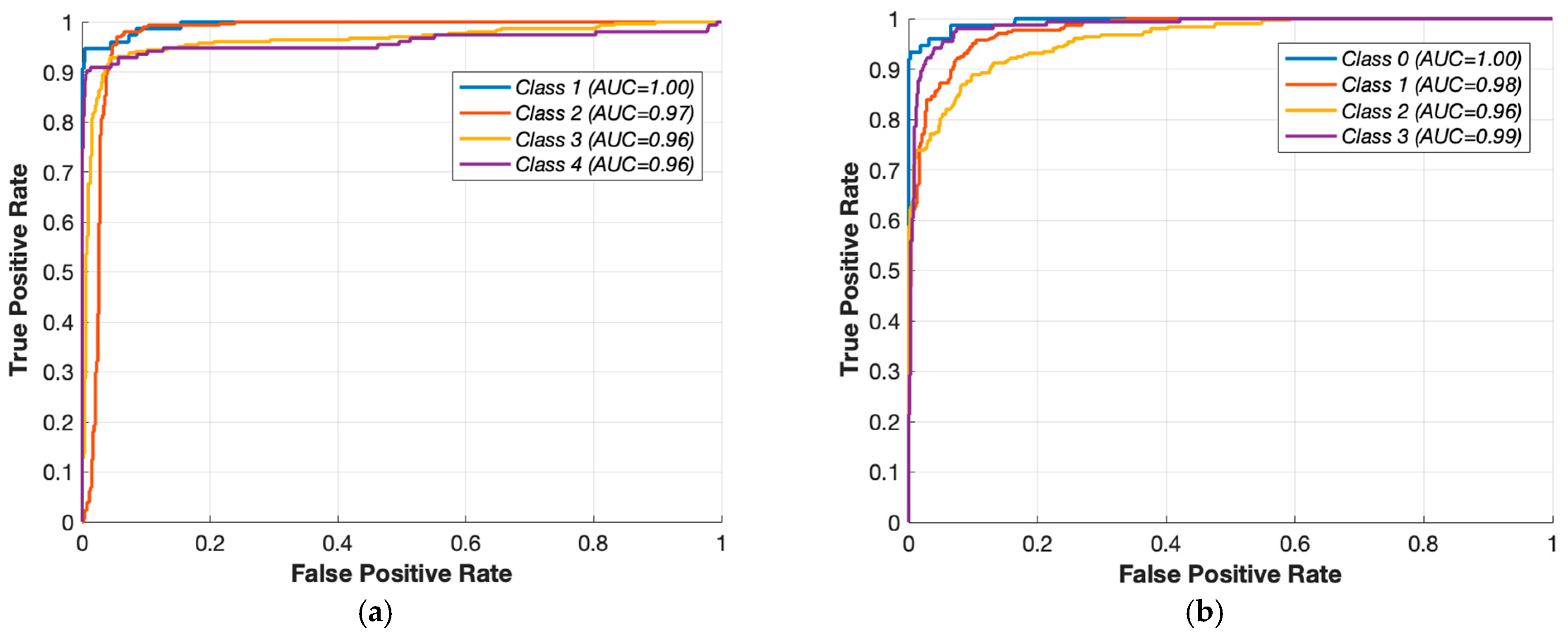
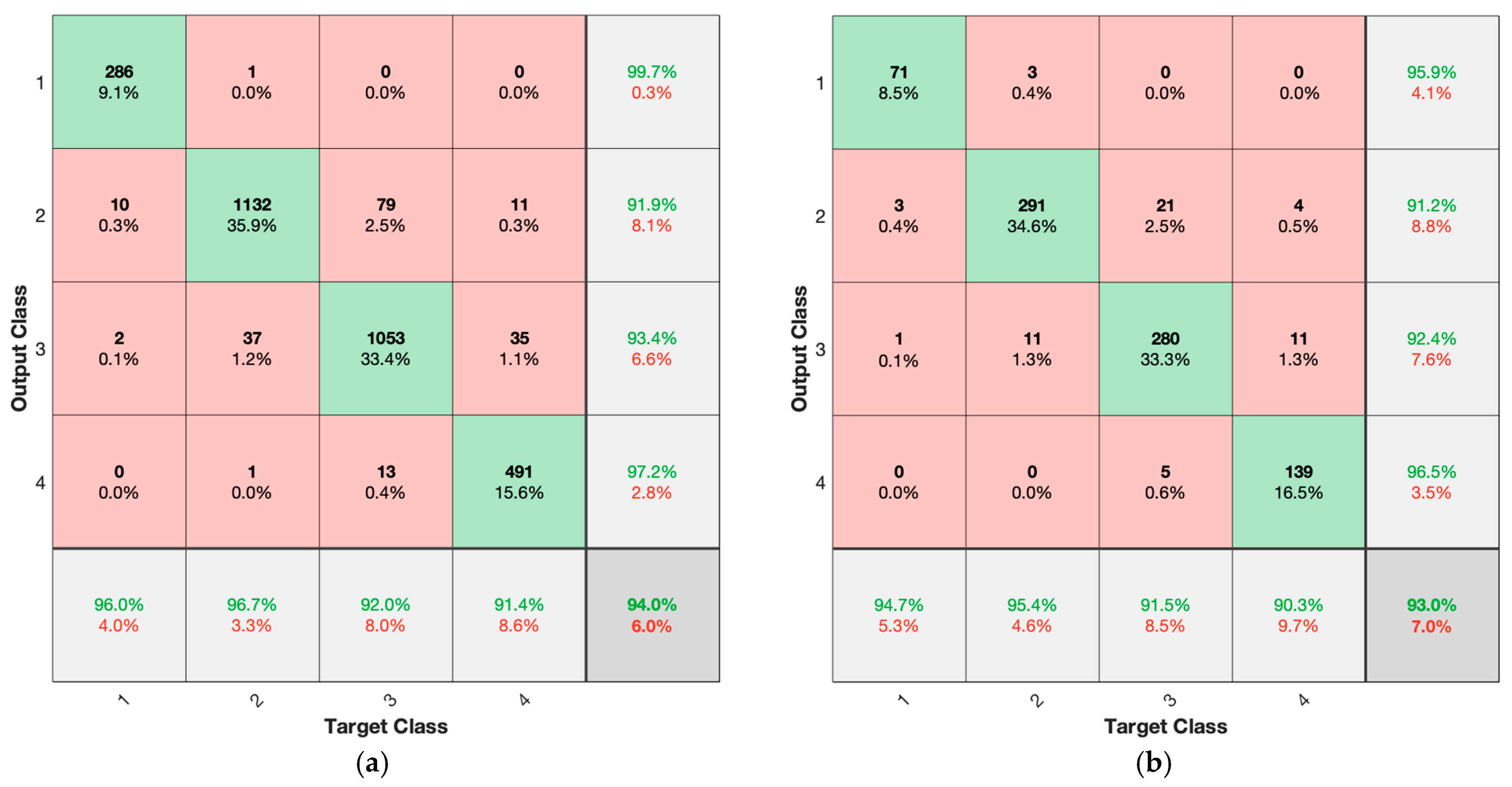
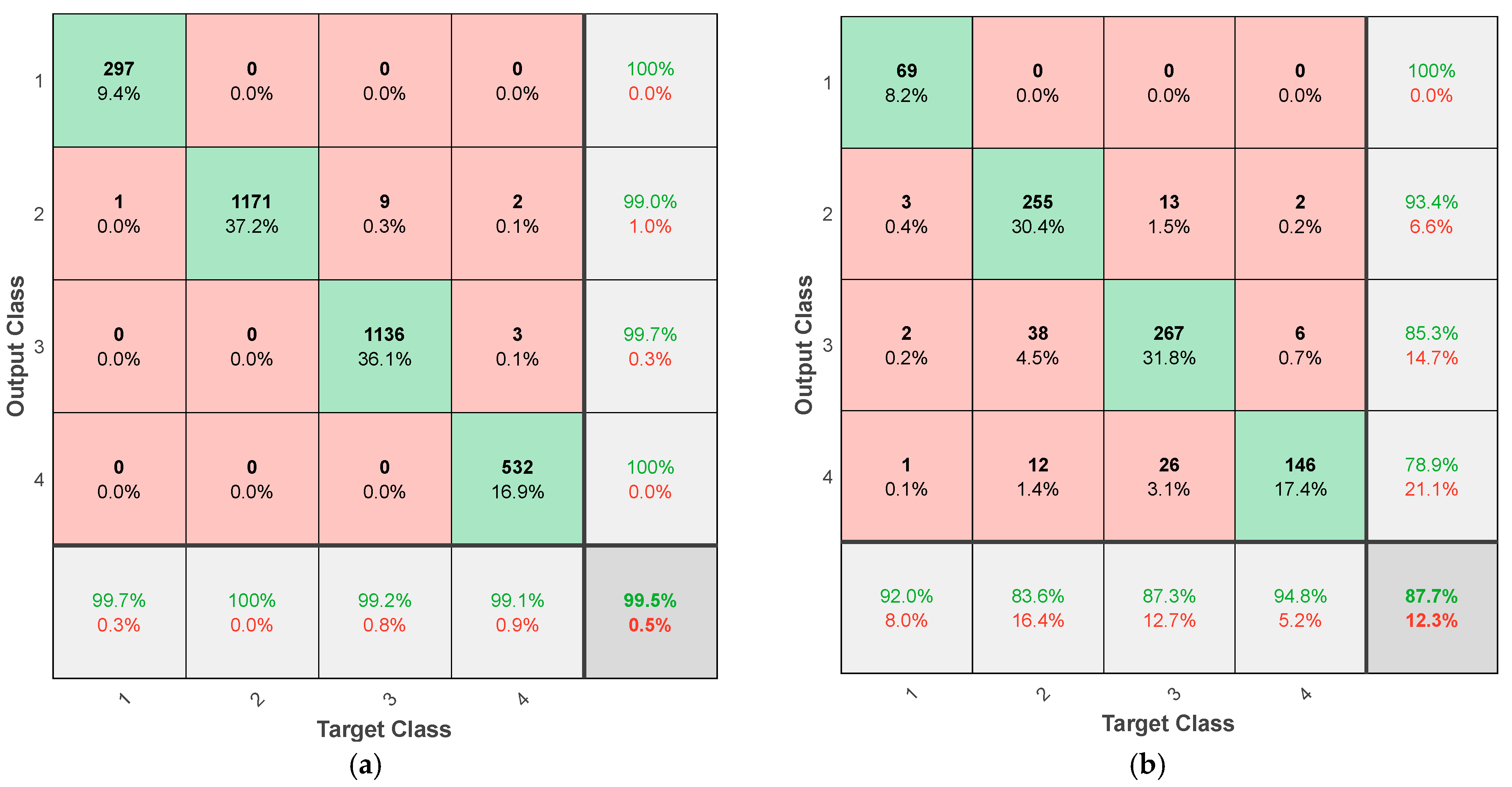
| Case ID | BP Diode 1 | BP Diode 2 | BP Diode 3 |
|---|---|---|---|
| 1 | Normal | Normal | Normal |
| 2 | Short-circuited | Normal | Normal |
| 3 | Open-circuited | Normal | Normal |
| 4 | Normal | Short-circuited | Normal |
| 5 | Short-circuited | Short-circuited | Normal |
| 6 | Open-circuited | Short-circuited | Normal |
| 7 | Normal | Open-circuited | Normal |
| 8 | Short-circuited | Open-circuited | Normal |
| 9 | Open-circuited | Open-circuited | Normal |
| 10 | Normal | Normal | Short-circuited |
| 11 | Short-circuited | Normal | Short-circuited |
| 12 | Open-circuited | Normal | Short-circuited |
| 13 | Normal | Short-circuited | Short-circuited |
| 14 | Short-circuited | Short-circuited | Short-circuited |
| 15 | Open-circuited | Short-circuited | Short-circuited |
| 16 | Normal | Open-circuited | Short-circuited |
| 17 | Short-circuited | Open-circuited | Short-circuited |
| 18 | Open-circuited | Open-circuited | Short-circuited |
| 19 | Normal | Normal | Open-circuited |
| 20 | Short-circuited | Normal | Open-circuited |
| 21 | Open-circuited | Normal | Open-circuited |
| 22 | Normal | Short-circuited | Open-circuited |
| 23 | Short-circuited | Short-circuited | Open-circuited |
| 24 | Open-circuited | Short-circuited | Open-circuited |
| 25 | Normal | Open-circuited | Open-circuited |
| 26 | Short-circuited | Open-circuited | Open-circuited |
| 27 | Open-circuited | Open-circuited | Open-circuited |
| Figure of Irradiance Scenario | Group | Included Cases |
|---|---|---|
| Figure 5 | 1 | Case 1, Case 7, Case 9, Case 17, Case 21 |
| 2 | Case 2, Case 3, Case 5, Case 10, Case 11, Case 19, Case 25 | |
| 3 | Case 4, Case 6, Case 8, Case 12, Case 13, Case 15, Case 16, Case 18, Case 20, Case 22, Case 23, Case 24, Case 26, Case 27 | |
| 4 | Case 14 | |
| Figure 6 | 1 | Case 6, Case 8, Case 12, Case 16, Case 18, Case 20, Case 22, Case 24, Case 26 |
| 2 | Case 3, Case 7, Case 9, Case 19, Case 21, Case 25, Case 27 | |
| 3 | Case 15, Case 17, Case 23 | |
| 4 | Case 1 | |
| 5 | Case 2, Case 4, Case 10 | |
| 6 | Case 14 | |
| 7 | Case 5, Case 11, Case 13 | |
| Figure 7 | 1 | Case 6, Case 8, Case 12, Case 16, Case 18, Case 20, Case 22, Case 24, Case 26 |
| 2 | Case 3, Case 7, Case 9, Case 19, Case 21, Case 25, Case 27 | |
| 3 | Case 15, Case 17, Case 23 | |
| 4 | Case 1 | |
| 5 | Case 2, Case 4, Case 10 | |
| 6 | Case 14 | |
| 7 | Case 5, Case 11, Case 13 |
| Irradiance ID | Pattern Description |
|---|---|
| Irradiance-1 | 500 W/m2 (1st module), 900 W/m2 (1/2 of remaining), 700 W/m2 (1/2 of remaining) |
| Irradiance-2 | 100 W/m2 (1st module), 1000 W/m2 (rest) |
| Irradiance-3 | 100 W/m2 (1st module), 900 W/m2 (1/3 of remaining), 1000 W/m2 (2/3 of remaining) |
| Irradiance-4 | 200 W/m2 (1st module), 900 W/m2 (1/2 of remaining), 1000 W/m2 (1/2 of remaining) |
| Irradiance-5 | 300 W/m2 (1st module), 900 W/m2 (2/3 of remaining), 1000 W/m2 (1/3 of remaining) |
| Irradiance-6 | 400 W/m2 (1st module), 800 W/m2 (1/3 of remaining), 1000 W/m2 (2/3 of remaining) |
| Irradiance-7 | 600 W/m2 (1st module), 800 W/m2 (1/2 of remaining), 1000 W/m2 (1/2 of remaining) |
| Irradiance-8 | 800 W/m2 (1st module), 800 W/m2 (2/3 of remaining), 1000 W/m2 (1/3 of remaining) |
| Classifier | Test Accuracy (%) | Avg. AUC (Test) | Training Accuracy (%) | Overfitting Risk | Generalization |
|---|---|---|---|---|---|
| ANN | 93.57 | 0.9925 | 95.18 | Low | High |
| SVM | 92.98 | 0.9800 | 94.00 | Low | High |
| RF | 87.74 | 0.9725 | 99.52 | High | Moderate |
Disclaimer/Publisher’s Note: The statements, opinions and data contained in all publications are solely those of the individual author(s) and contributor(s) and not of MDPI and/or the editor(s). MDPI and/or the editor(s) disclaim responsibility for any injury to people or property resulting from any ideas, methods, instructions or products referred to in the content. |
© 2025 by the author. Licensee MDPI, Basel, Switzerland. This article is an open access article distributed under the terms and conditions of the Creative Commons Attribution (CC BY) license (https://creativecommons.org/licenses/by/4.0/).
Share and Cite
Sezgin-Ugranlı, H.G. From Shadows to Signatures: Interpreting Bypass Diode Faults in PV Modules Under Partial Shading Through Data-Driven Models. Electronics 2025, 14, 3270. https://doi.org/10.3390/electronics14163270
Sezgin-Ugranlı HG. From Shadows to Signatures: Interpreting Bypass Diode Faults in PV Modules Under Partial Shading Through Data-Driven Models. Electronics. 2025; 14(16):3270. https://doi.org/10.3390/electronics14163270
Chicago/Turabian StyleSezgin-Ugranlı, Hatice Gül. 2025. "From Shadows to Signatures: Interpreting Bypass Diode Faults in PV Modules Under Partial Shading Through Data-Driven Models" Electronics 14, no. 16: 3270. https://doi.org/10.3390/electronics14163270
APA StyleSezgin-Ugranlı, H. G. (2025). From Shadows to Signatures: Interpreting Bypass Diode Faults in PV Modules Under Partial Shading Through Data-Driven Models. Electronics, 14(16), 3270. https://doi.org/10.3390/electronics14163270






